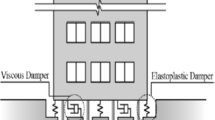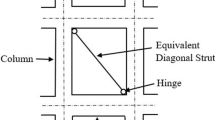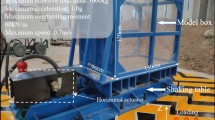Abstract
In this paper, the probabilistic seismic performance of vertically irregular steel buildings, considering soil–structure interaction effects, is evaluated. Various irregular distributions of structural properties, including mass, stiffness and strength along the height of three-dimensional moment resisting steel frames were intended. The finite element model of soil medium was created with solid elements below the structure. The nonlinear material behavior of soil was considered as well. Nonlinear incremental dynamic analysis was performed to evaluate the flexible-base structural performance in the framework of probabilistic performance-based earthquake engineering. According to the median curves of intensity demand of structures, it is concluded that non-uniform height-wise distribution of lateral resistance properties of steel structures varies the displacement demand and the seismic capacity of the irregular frames, compare to the regular structure. The capacity variation of most irregular frames is more obvious at the nonlinear phase of structural behavior. Due to the foundation flexibility, the damage concentration raises in the bottom floor and the irregularity increases the seismic demands of the lower floors of the system. Among all the irregular steel frames, the average increase of the displacement demand and reduction of the seismic capacity are maximal for the strength and concurrent variation of stiffness and strength irregularity models, respectively. Additionally, mass irregularity shows minor influence in the seismic demand and capacity variations of the steel frames. The predominant influence of stiffness and strength irregularities (soft and weak story) is observed in reduction of the structural ductility factor and the mean annual frequency of exceeding limit states.















Similar content being viewed by others
Notes
The modification factors change resistance properties of both the regular and irregular stories of the irregular structures, so the fundamental period and the base shear of the irregular models are the same as the regular structure; but the total lateral resistance properties are not distributed the same along the structure height. Therefore, a contrast is observed in the performance level of the regular and irregular structures.
References
Habibi A, Asadi K (2016) Development of drift-based damage index for reinforced concrete moment resisting frames with setback. Int J Civ Eng, 1–12. doi:10.1007/s40999-016-0085-3
Badri RK, Moghadam AS, Nekooei M (2016) The influence of deterioration parameters on the response of low-rise symmetric and asymmetric rc buildings. Int J Civ Eng 14:547–560. doi:10.1007/s40999-016-0038-x
BHRC (2014) Standard 2800. 4th ed: Building and Housing Research Centre, Tehran, Iran
Institute SE (2010) Minimum design loads for buildings and other structures: ASCE/SEI 7–10: American society of civil engineers
Valmundsson EV, Nau JM (1997) Seismic response of building frames with vertical structural irregularities. J Struct Eng 123:30–41
Mendoza M, Romo M (1989) Behavior of building foundations in Mexico City during the 1985 Earthquake: Second stage. Lessons learned from the Mexico earthquake Publication, pp 89–102
Gajan S, Saravanathiiban DS (2011) Modeling of energy dissipation in structural devices and foundation soil during seismic loading. Soil Dyn Earthq Eng 31:1106–1122
Rajeev P, Tesfamariam S (2012) Seismic fragilities of non-ductile reinforced concrete frames with consideration of soil structure interaction. Soil Dyn Earthq Eng 40:78–86
Shakib H, Fuladgar A (2004) Dynamic soil–structure interaction effects on the seismic response of asymmetric buildings. Soil Dyn Earthq Eng 24:379–388
Moghaddasi M, Cubrinovski M, Chase JG, Pampanin S, Carr A (2011) Effects of soil–foundation–structure interaction on seismic structural response via robust Monte Carlo simulation. Eng Struct 33:1338–1347
Raychowdhury P (2009) Effect of soil parameter uncertainty on seismic demand of low-rise steel buildings on dense silty sand. Soil Dyn Earthq Eng 29:1367–1378
Venanzi I, Salciarini D, Tamagnini C (2014) The effect of soil–foundation–structure interaction on the wind-induced response of tall buildings. Eng Struct 79:117–130
Vatanchian M, Shooshtari A (2016) Investigation of soil–structure interaction effects on seismic response of a 5 MW wind turbine. Int J Civ Eng 1–17. doi:10.1007/s40999-016-0059-5
ATC A 40 (1996) Seismic evaluation and retrofit of concrete buildings. Applied Technology Council, report ATC-40 Redwood City
Agency FEM (1997) Nehrp guidelines for the seismmic rehabilitation of buildings (FEMA Publication 273). Federal Emergency Management Agency Washington
FEMA. Recommended seismic design criteria for new steel moment-frame buildings. Washington DC2000
Jalayer F (2003) Direct Probabilistic Seismic Anaysis: Implementing Non-linear Dynamic Assessments: Stanford University
Jalayer F, Cornell CA (2004) A technical framework for probability-based demand and capacity factor design (DCFD) seismic formats: Pacific Earthquake Engineering Research Center
Shome CAC N (1999) Probabilistic seismic demand analysis of non-linear structures. Stanford University, Stanford, CA
CA C (1964) Stochastic processes in civil engineering. Stanford University, Stanford, CA
Pirizadeh M, Shakib H (2013) Probabilistic seismic performance evaluation of non-geometric vertically irregular steel buildings. J Constr Steel Res 82:88–98
Karavasilis TL, Bazeos N, Beskos D (2008) Estimation of seismic inelastic deformation demands in plane steel MRF with vertical mass irregularities. Eng Struct 30:3265–3275
Tremblay R, Poncet L (2005) Seismic performance of concentrically braced steel frames in multistory buildings with mass irregularity. J Struct Eng 131:1363–1375
Chintanapakdee C, Chopra AK (2004) Seismic response of vertically irregular frames: response history and modal pushover analyses. J Struct Eng 130:1177–1185
Rajeev P, Tesfamariam S (2012) Seismic fragilities for reinforced concrete buildings with consideration of irregularities. Struct Saf 39:1–13
Shakib H, Ghasemi A (2007) Considering different criteria for minimizing torsional response of asymmetric structures under near-fault and far-fault excitations. Int J Civ Eng 5:247–265
Shakib H, Atefatdoost G (2014) Minimizing the torsional response of asymmetric wall-type systems considering soil-structure interaction. Int J Civ Eng 12:14–24
Pinho R, Antoniou S (2005) A displacement-based adaptive pushover algorithm for assessment of vertically irregular frames. Proceedings of the 4th European workshop on the seismic behaviour of irregular and complex structures, CD ROM Thessaloniki2005
Chen C, Lam N, Mendis P (2000) The bifurcation behaviour of vertically irregular buildings in low seismicity regions. Proceedings of the 12th World Conference on Earthquake Engineering, Auckland, NZ, Paper 2000
Al-Ali AA, Krawinkler H (1998) Effects of vertical irregularities on seismic behavior of building structures: John A. Blume Earthquake Engineering Center
Building National Code of Iran-Loads for Buildings (2014) Institute of Building National Code
Yang Z, Elgamal A-WM (2000) Numerical modeling of earthquake site response including dilation and liquefaction: University of California at San Diego, Dept. of Structural Engineering
Hoseyni SM, Yousefpour F, Aghaei Araei A, Karimi K, Hoseyni SM (2014) Effects of soil-structure interaction on fragility and seismic risk; a case study of power plant containment. J Loss Prev Process Ind 32:276–285
Mazzoni S, McKenna F, Scott MH, Fenves GL (2006) OpenSees command language manual. Pacific Earthquake Engineering Research (PEER) Center
Neuenhofer A, Filippou FC (1997) Evaluation of nonlinear frame finite-element models. J Struct Eng 123:958–966
Vamvatsikos D, Alexandropoulos K, Giannitsas P, Zeris C (2006) Influence of element modeling on the predicted seismic performance of an existing RC building
Asgarian B, Sadrinezhad A, Alanjari P (2010) Seismic performance evaluation of steel moment resisting frames through incremental dynamic analysis. J Constr Steel Res 66:178–190
H. K. (2000) State of art report on systems performance of moment resisting steel frames subject to earthquake ground shaking. SAC report no. FEMA 355 C. FEMA, Washington (DC)
Preisig M, Jeremic B (2005) Nonlinear finite element analysis of dynamic soil-foundation-structure interaction: University of California, Davis
Rayhani M, El Naggar MH (2008) Numerical modeling of seismic response of rigid foundation on soft soil. Int J Geomech 8:336–346
Hokmabadi AS, Fatahi B, Samali B (2014) Assessment of soil–pile–structure interaction influencing seismic response of mid-rise buildings sitting on floating pile foundations. Comput Geotech 55:172–186
Kramer S (1996) Geotechnical earthquake engineering. Prentice Hall, Upper Saddle River, NJ
Idriss I, Sun JI (1992) User’s Manual for SHAKE91. Center for Geotechnical Modeling, Department of Civil Engineering, University of California, Davis
Jalayer F, Cornell C (2009) Alternative non-linear demand estimation methods for probability-based seismic assessments. Earthq Eng Struct Dyn 38:951–972
Vamvatsikos D, Cornell CA (2002) Incremental dynamic analysis. Earthq Eng Struct Dyn 31:491–514
Author information
Authors and Affiliations
Corresponding author
Rights and permissions
About this article
Cite this article
Homaei, F., Shakib, H. & Soltani, M. Probabilistic Seismic Performance Evaluation of Vertically Irregular Steel Building Considering Soil–Structure Interaction. Int J Civ Eng 15, 611–625 (2017). https://doi.org/10.1007/s40999-017-0165-z
Received:
Revised:
Accepted:
Published:
Issue Date:
DOI: https://doi.org/10.1007/s40999-017-0165-z




